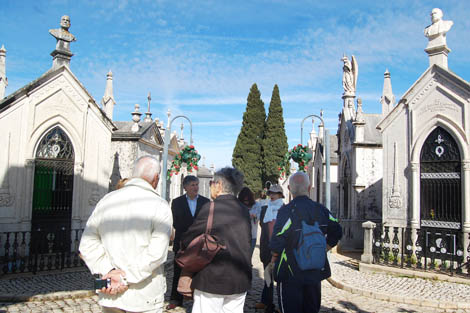 Can cemeteries be more than places of sadness and death? They can. This was proved once again this Saturday, with the cultural visit to the Cemetery of Loulé, guided by Luís Guerreiro and Luísa Martins, researchers of local History and Culture, and promoted by the City Council as part of the commemorations of the International Day of Monuments and Sites .
Can cemeteries be more than places of sadness and death? They can. This was proved once again this Saturday, with the cultural visit to the Cemetery of Loulé, guided by Luís Guerreiro and Luísa Martins, researchers of local History and Culture, and promoted by the City Council as part of the commemorations of the International Day of Monuments and Sites .
“In addition to its religious significance and memory, this cemetery is also an excellent source of information, to better understand the contemporary history of Loulé”, stressed Luís Guerreiro, right at the beginning of the visit of the group of around ten and a half people. "The cemeteries are authentic open-air museums," he stressed.
«A cemetery is a space that is socially visited on November 1st and when a family member or friend dies. But our strategy in Loulé is to value memory. We have a museological project in Loulé that goes beyond archeology. Therefore, we consider that a cemetery like ours is not just sadness, but memory and culture», added Joaquim Guerreiro, Councilor for Culture at the Loulé Chamber, and one of the participants in the visit.
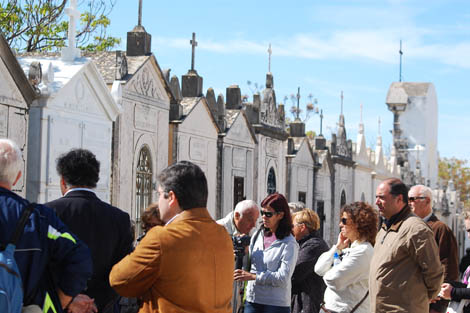 The current Loulé Cemetery was inaugurated in 1918, at the time of pneumonic disease, a disease that killed thousands of people across the country. Luísa Martins recalled the real wars that took place in Portugal since the XNUMXth century, to end the religious and unhygienic tradition of burying the dead inside churches and in their churchyards.
The current Loulé Cemetery was inaugurated in 1918, at the time of pneumonic disease, a disease that killed thousands of people across the country. Luísa Martins recalled the real wars that took place in Portugal since the XNUMXth century, to end the religious and unhygienic tradition of burying the dead inside churches and in their churchyards.
Civil cemeteries, far from churches and villages, were the result of a concern with public health, but even so, their creation was highly contested by people connected to the Catholic Church. In such a way that, as Luísa Martins pointed out, this issue was really at the origin of one of the many revolts of the XNUMXth century, the Maria da Fonte.
But, especially after the establishment of the Republic, civil cemeteries ended up imposing themselves. And they also translated the social structure and even the political thought of those who had their last rest there. In Loulé, the cemetery has a wide central street, from which other streets depart. Right at the entrance, on each side of this central street, are the tombs of the two most important families in the village.
"José Martins Farrajota and Maria das Dores Farrajota and Family" and "Angelo José de Castro and Family" are the inscriptions that can be read on the front of each of the tombs, decorated with Masonic and lay motifs, as both, in addition to being wealthy and influential merchants, they were also prominent republicans.
Luísa Martins recalled that Masonic and lay ideals intended that people, since they are not equal in life, at least were equal in death. Beautiful ideas, but the very spatial configuration of Loulé Cemetery belies, «with the richest in the center and on one side and the poorest in the background and on the other side, reflecting the social reality of the village», as he underlined, in his on the side, Luís Guerreiro.
Masonic symbols in a civil cemetery
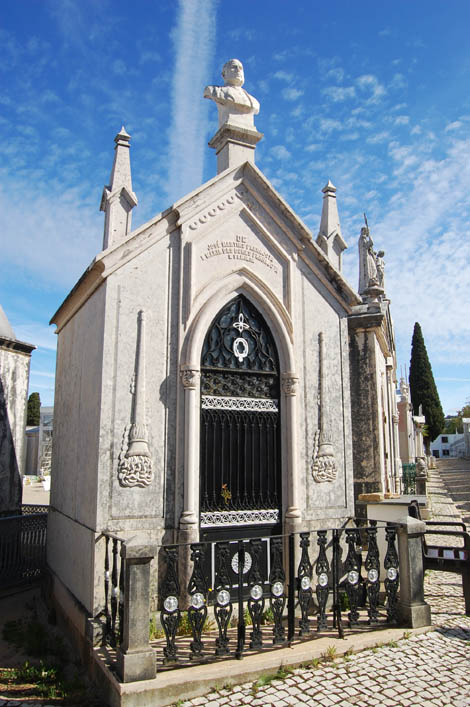 During the visit, the researcher drew attention to the symbolic aspects of the decorations of the tombs, many with columns on the façade (a Masonic element par excellence, as they represent the Temple of Solomon with its columns), with its inverted beams (symbol of life that vanishes), acanthus or laurel leaves, flowers, flames, angels, crosses, the sickle or scythe of death, the skull, among many others. Altogether, in Portugal, recalled Luísa Martins, more than one hundred cemetery signs have been identified.
During the visit, the researcher drew attention to the symbolic aspects of the decorations of the tombs, many with columns on the façade (a Masonic element par excellence, as they represent the Temple of Solomon with its columns), with its inverted beams (symbol of life that vanishes), acanthus or laurel leaves, flowers, flames, angels, crosses, the sickle or scythe of death, the skull, among many others. Altogether, in Portugal, recalled Luísa Martins, more than one hundred cemetery signs have been identified.
Luís Guerreiro revealed that both José Martins Farrajota and Ângelo José de Castro died years before the inauguration of the current Cemetery, but were transferred to the new graves. In the wide street on the right, there are the tombs of other important families, such as the one bearing the stone inscription "Família Magalhães" and where Duarte Pacheco, minister of Public Works of Salazar, responsible for the investment impulse that has changed, is buried. the country, especially Lisbon, with the airport, the highway, the Instituto Superior Técnico, the Estádio Nacional, the new neighborhoods of Alvalade, Encarnação, Madredeus and Caselas, in Lisbon. Duarte Pacheco, a native of Loulé, died prematurely in a car accident in 1943 and is buried in his native land.
Next is the tomb of Frutuoso da Silva, another rich merchant, who built the Cine-Teatro Louletano, or that of «Joaquim Marcello Adelino and his Family», a beautiful architectural and sculptural piece, flanked by two lateral angels, with inscriptions «Eternity» and «Truth». In this case, as in so many others, the tomb is decorated with Masonic symbols – the columns, for example -, but it also bears a cross, a «commitment between church and secular space» that ended up prevailing.
Then, on that street, there is the tomb of «Manoel dos Santos Gallo», who was the first administrator of the municipality of Loulé after the implantation of the Republic, as well as one of the founders of the Centro Republicano Azevedo e Silva. His son Manuel dos Santos Gallo Júnior is also buried there, who, as Luís Guerreiro recounted, died in Lisbon in 1912, victim of a bomb that exploded beside him during one of the many violent skirmishes that broke out in the capital of the Republic at that time. «He was in Lisbon and, driven by curiosity, he went to Rossio to see what was going on. That bomb went off at his foot and he died».
Ahead is a more recent tomb, covered with plaques with verses inscribed. There is buried Francisco Nobre Portela, who was a cyclist in France and in his homeland he was part of the Louletano team in the 30s of the XNUMXth century. He participated in two trips to Portugal, was a prestigious merchant and poet.
Stories and mysteries still to be investigated
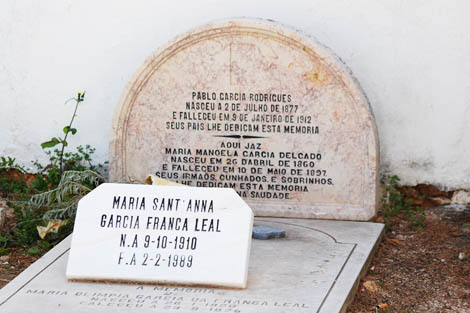 Continuing along this street on the right, there is a different funerary monument, which celebrates a young Spanish soldier belonging to the Order of the Tower and Sword. Who would this soldier be? Luís Guerreiro doesn't know, but he promises to go looking for information that he can reveal on his next cultural visit to Loulé Cemetery.
Continuing along this street on the right, there is a different funerary monument, which celebrates a young Spanish soldier belonging to the Order of the Tower and Sword. Who would this soldier be? Luís Guerreiro doesn't know, but he promises to go looking for information that he can reveal on his next cultural visit to Loulé Cemetery.
The investigator points out, in fact, that in this cemetery there are many Spaniards. The first wave of these Spaniards came mainly from the area of Vila Nueva de Castelejos, in the province of Huelva, in the XNUMXth century, pushed first by the French invasions and then by the Carlist civil war.
“Most of these Spaniards settled in Loulé as a merchant. Most of the shopping street was theirs. Even today there are many descendants of these Spaniards in Loulé. The Romeros, Formosinhos, Pablos, Franca are their descendants», said Luís Guerreiro. In fact, in the group of people who participated in the visit, there was precisely a member of the Franca family.
But there was still another wave of Spaniards, already in the 2th century, of different origin, and who are also buried in Loulé. In another part of the cemetery, in a shallow grave and only marked with tombstones with their names in Latin, are buried some of the Jesuit priests who, after the 1934nd Spanish Republic, fled from the neighboring country. Colegio Gonzaga, a large Spanish Jesuit institution, moved to Loulé between 1939 and XNUMX, having functioned in the Palácio Gama Lobos, still called Palácio dos Espanhóis today.
«In the first year of operation in Portugal, this College operated at Quinta de Marim, in Olhão, but the following year they came to Loulé, where there were as many as 60 people, so that a new wing was even built in the Gama Lobos palace, for cafeteria and other purposes'. With the Jesuit priests came some of their Spanish students and their mothers, as well as nuns, who settled in the Convento do Espírito Santo. “But he was a very discreet presence, in such a way that there are no references to his stay in the newspapers of the time or in the minutes of the Chamber”, strange Luís Guerreiro.
Returning to the rich area in this Loulé Cemetery, the investigator underlined that the main street – almost a copy of the main avenue of a city – could be called «jokingly, the avenue of the presidents of the City Council», given the number of ex. -mayors who are buried here.
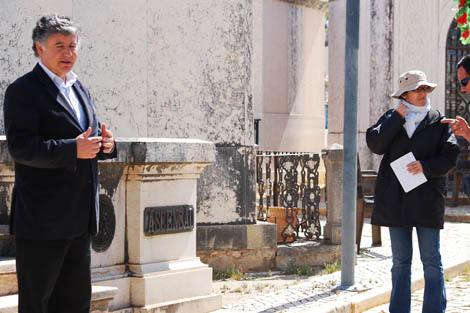 One of them rests in the «most enigmatic funerary monument in the entire cemetery», as Luísa Martins underlined. It's a low-rise mausoleum, with a stairway that leads nowhere and never seems to have been finished. However, the funerary space includes an underground catacomb with a chapel.
One of them rests in the «most enigmatic funerary monument in the entire cemetery», as Luísa Martins underlined. It's a low-rise mausoleum, with a stairway that leads nowhere and never seems to have been finished. However, the funerary space includes an underground catacomb with a chapel.
This mausoleum belongs to José da Costa Ascensão, presented by Luís Guerreiro as a “pure and tough republican”, who was responsible for the design of a large avenue that would lead to Mãe Soberana, the sanctuary on top of a hill near Loulé. "It was a very controversial project, which never came to fruition."
On the same street is the tomb of José da Costa Mealha, who was also the mayor and whose name today identifies the central avenue of Loulé, where Carnival takes place. “He was a great dried fruit merchant, a wealthy man, who traveled a lot,” said Luís Guerreiro. «At the end of the XNUMXth century and the beginning of the XNUMXth century, the great merchants, especially of nuts, were the most wealthy class and also the ones who traveled the most, on business, throughout Europe. And on these trips they came into contact with new ideas, which they brought to the Algarve», added the researcher.
In this wing of the more affluent there is still the tomb of José do Carmo Penis, just like that, without the accent on the “and”… “Don't laugh”, asked Luís Guerreiro with a smile. It's just a name.
The almost shallow grave of the poet Aleixo
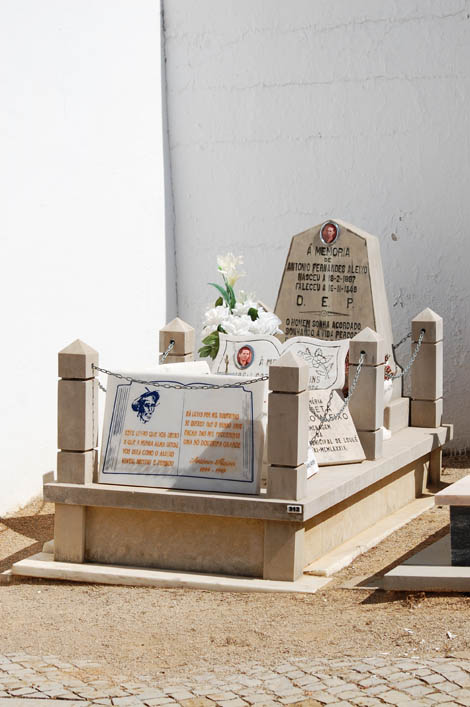 But the story of the Cemetery of Loulé is not only made of great merchants and former mayors. Among the many men of culture who are buried there, the highlight goes to António Fernandes Aleixo, who was a guard, herdsman, an emigrant in France, a policeman and a poet. It rests in an almost shallow grave, covered with a marble tombstone that bears one of its blocks, in the popular area of the cemetery.
But the story of the Cemetery of Loulé is not only made of great merchants and former mayors. Among the many men of culture who are buried there, the highlight goes to António Fernandes Aleixo, who was a guard, herdsman, an emigrant in France, a policeman and a poet. It rests in an almost shallow grave, covered with a marble tombstone that bears one of its blocks, in the popular area of the cemetery.
And in the same cemetery there is also Joaquim Magalhães, who was a teacher, but ended up being known as the discoverer and “secretary” of António Aleixo, since he was the one who set his writings and organized his poems.
“People today are still afraid to go in here, but this is a place of great tranquility. It is also a place with history, marked by romantic and revivalist architecture», stressed Luís Guerreiro, at the end of the visit of more than two hours.
«Who were the builders of these monuments?», wondered, in conclusion, Luísa Martins. A topic to be investigated and that could be, who knows, unraveled on the next cultural visit to the Cemetery of Loulé.
It's just that, as guaranteed to the Sul Informação Culture councilor Joaquim Guerreiro, this was the third visit of its kind, but the Chamber will regularly promote two annual visits, at the time of Monuments Day, in April, and the European Heritage Days, in September.
“Cemetery tourism is already taking place throughout Europe, and there are even tourists who, when they visit a land, go to its cemetery to understand the local structure of that land,” added Joaquim Guerreiro. And the guided cultural visits to the Loulé Cemetery are just another piece – quite original – in the municipality's cultural strategy.
Mark your agenda: in September there will be another visit. And, believe me, it will be a very interesting and well spent morning, on a journey through time and memory guided by two excellent storytellers.
See the Photogallery about this cultural visit to Loulé Cemetery
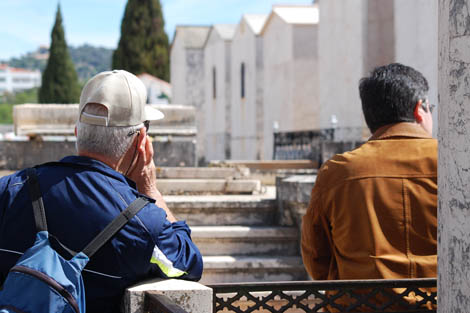

















Comments